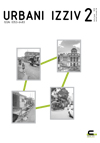Evaluating issues and performance of a public transport network in a post-communist city using a quantitative spatial approach
Evaluating issues and performance of a public transport network in a post-communist city using a quantitative spatial approach
Author(s): Lucian-Ionuț Roșu, Alexandra BlăgeanuSubject(s): Social Sciences, Rural and urban sociology
Published by: Urbanistični inštitut Republike Slovenije
Keywords: performance measurement; public transport assessment; geospatial analyses; clustering analysis; Iaşi
Summary/Abstract: The urban dynamics in eastern Europe after the fall of communism (seen as a consequence of the changes generated by the transition to a new ideology) have highlighted deficiencies in local public services, including the public transport system. To identify and illustrate the shortcomings of a public transport system from this region, we analysed the transport network of Iaşi (Romania) by taking into consideration various dimensions of efficiency. Partial indicators were used as input for a geospatial analysis and to create complex indicators, which can be used both as tools to measure the performance of a public transport network and as instruments to evaluate the local administration and decision-makers. The results highlight the performance level of the transport network analysed, revealing a core-periphery structure (in the context of a polynucleated city) resulting from relics of the communist period. A GIS analysis was used to assess the efficiency of the public transport network in order to identify and visualise strengths and weaknesses in the local transport system.
Journal: Urbani izziv
- Issue Year: 26/2015
- Issue No: 2
- Page Range: 103-116
- Page Count: 14
- Language: English

